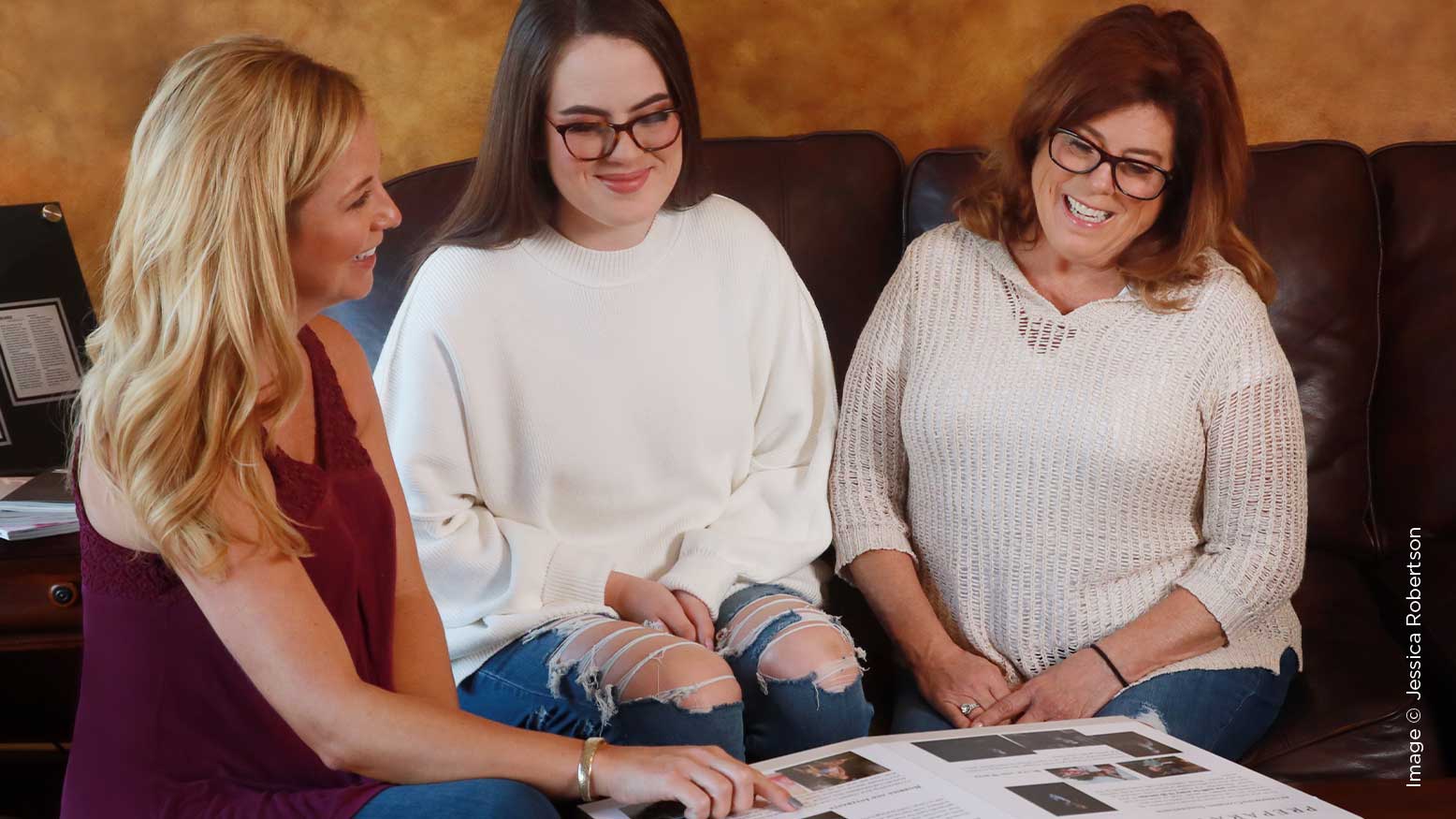10 Things I Wish I Had Known When I Started My Business with Jessica Robertson
Writing this article is not about regrets; it is about my strong desire to share with others the key components of our success in the hope that others will also be successful. As an industry, we can all rise together if we are willing to share. I am well aware this list could be much longer, but these have been the most critical elements to our longevity and financial stability.
1. IT DOESN’T MATTER HOW GOOD YOU ARE AT YOUR CRAFT IF YOU DON’T HAVE A SOLID BUSINESS FOUNDATION
If most photographers spent as much time learning about how to run and nurture their businesses as they do learning about the newest lights, cameras or lenses, we would have more longevity in the industry. But having watched many talented photographers leave/be forced out of the industry because of financial failure, I have realized that as an industry, we undervalue ourselves and our craft. The reality of it is that none of us are great in business when we start. Just like with your craft, you have to learn, grow and evolve your business skills.
In our business, we recognize that we are not our ideal client. Therefore, we should not be pricing our services or products around our personal ability to pay for them. Once we realized that our seniors spent more on the clothing they were wearing during their portrait sessions than they were investing directly with us, our mindset changed. They are capable of spending if we create must-have portraits and products.
2. DON’T GET CAUGHT UP IN AND BURDENED BY EQUIPMENT
Some of the most successful businesses I know don’t have the newest equipment. It is not the gear that makes them successful, it is the artist behind the camera. We determine if the purchase is necessary by asking the question, “If I buy __________, will my clients benefit and/or be able to see a significant difference?”
When significant change occurs technologically, it can also be necessary. When we upgraded our lighting to Profoto because of the high-speed sync technology, both the clients’ and my creativity benefited. This was a significant investment, so we set goals, saved for the purchase, and then invested. We did not take on debt and were not burdened by the weight of buying something we could not afford. Invest only in what you need, not in all your wants.
3. YOUR PRODUCTS MUST MATCH YOUR IMAGERY AND YOUR BRAND, AND YOU MUST BE ABLE TO SHOW YOUR CLIENTS THEY NEED IT
For many years, I would see the newest products at tradeshows, and I would want to bring those to our clients. At the time, I did not have a clear handle on my brand nor my clients’ styles. While I really like a modern look, most of my clients are more traditional (our studio is in the South, in Virginia). Narrowing your products but not limiting your clients’ spending is tricky. We sell wall clusters to most of our clients. They match our brand, printed on acrylic or canvas gallery wraps, and they highlight our imagery. Hanging in a client’s home, these are advertising for us, but they also meet the client’s desire to not have to narrow down their portrait selection to just one or two images. Our cluster grouping offerings range from four to seven portraits.
About 80 percent of our senior clients are athletes, and for years, we did not have a product that highlighted the sports images we were creating. So ultimately, clients narrowed the images down to their favorite one or two. This was not good for our profit or for our client experience. Sports montages don’t match our clients’ style or our brand. We now sell “10×30 Sports Composites” that are simple and clean. This has helped raise our average sale significantly, and our clients love them! As an extension of this product, we now also offer “Hobby and Interest Composites.” Again, we always want to provide a product for the imagery we create.
4. OUTSOURCE AND PARTNER WISELY BY DELEGATING YOUR WEAKNESSES
There are many things I am not good at, and I realized that early on. As a business owner, you wear many hats, and as most of us do at the beginning, I did everything for my business, not realizing it was stunting the growth. Quickly, I learned that I am not good at selling my own photography. One of my first goals was to hire someone to help specifically with that integral task, someone who would be better at selling than I was. That same person took on one of the other tasks I didn’t want to do: culling and processing my images after a session. Next, I found that I didn’t want to do detailed editing of my images. Someone else can take zits and stray hairs away and I can still maintain the artistry, so we partnered with a retouching company. Confession: yes, I am still a control freak, so I review and do a final edit to all of my images.
I played all roles for too long, and as a result, my business took longer to grow. By trying to do it all, I either worked late into the night, processed rather than photographed, or missed out on time with my family. By sharing the load, I spend more time creating images to sell while gaining more balance in my life. I strongly encourage you to hire and outsource sooner than you think you should.
We operate as a tricycle, as we jokingly refer to ourselves. Thankfully, Robin still handles processing, sales, and client communication, while Karen oversees editing, design, framing, and overall quality control. While my name is on the building and I am “out front” with the public, I could not be successful without my team.
5. TREAT PEOPLE LIKE YOU WOULD LIKE TO BE TREATED. EXPERIENCE STILL MATTERS.
Often in our studio, we ask ourselves, “How would you like to be treated?” This is our gauge for determining a process or procedure for our clients. We have excellent client retention, and I believe this is due to giving our clients a great experience coupled with quality imagery they love.
With that mindset, when we started our business, I was not comfortable with the traditional In-Person Sales Model. If I am going to make a large investment, I need some time to digest and think about my purchase. So, again, treating our clients how we would like to be treated, our process starts with an in-person consultation, followed by the session, and then we have a Modified In-Person Sales Process. We post our images online through N-Vu one week after the session and one week before the ordering session. Why release this “control?” Simply because it is how we would like to be treated. It is also practical, because it is not uncommon for our senior clients to wear eight outfits, and we typically show 20-25 images of each outfit. With having to review so many images, a traditional “lock-them-in-a-room-until-they-order” process can be counterproductive. Our clients come in excited and ready for guidance. They have photographed places in their home to hang their portraits, and therefore we are in a place to help rather than conduct high-pressure sales.
6. ESTABLISH A PROCESS TO GIVE SECURITY TO YOUR CLIENT AND CREATIVITY TO YOU
Ultimately, I want to run the most profitable business I can, and knowing a confused client doesn’t invest as much, we established a clear process for our clients. At the core of our process are in-person consultations, which have been critical for the success of our business. These are not something that I will delegate, because next to taking the photographs, they are the most important step in our process. This is where we establish our relationship, learn a client’s story and vision, plan out the details of their session, and review portrait and album options to start planning for the sale. Ultimately, our clients leave as advocates for us, because we have shown our value.
7. GIVE
I strongly believe that if you expect your community to support you, you should be giving to your community. I started my business in a community to which I had no connection at all. Scary! So, I jumped into the local business organizations and started volunteering. And while I also believe it is good to be involved in photographic organizations, it is critical to the growth of your business to be a part of the business community where you live and work. I partnered with like-minded businesses such as our favorite sandwich shop and put up a display. I volunteered at our local schools to teach basic photography. I offered headshots to business group members at a special rate. I photographed the police department for free. For over ten years, we have supported our local Humane Society through a special pet event. By doing things like this, my reputation grew, and so did the trust my community had in our newly established business. The relationships I cultivated in the infancy of our business still feed and grow us today.
Giving to our communities is something that feeds our souls, but it is also a critical part of networking. Networking is not dead, but your business will be if you don’t network and give to your community.
8. COVER YOUR ASS
I’m not an attorney, insurance agent, or an accountant, but …
Register your business, and determine what the proper business entity is so that you and your family are not held personally responsible if someone takes legal action against your company. Likewise, plan for the taxes that go along with that business type at the end of the year—30 percent at minimum.
To protect the business, be sure that you are set up with appropriate insurance to cover what you have created. Accidents happen, and you don’t want one to destroy what you’ve built.
Along with legally setting up your business, be sure you have protected the imagery you create through copyright clarity with your clients, as well as model releases and contracts.
When you are planning for taxes, also plan for retirement. Just like paying yourself, this is crucial.
9. PERFECTION IS THE DEATH OF A BUSINESS … BUT SO IS BEING LAZY
As a perfectionist, this is hard to even write. Striving for perfection is part of why we have been successful. But that same perfectionism has held us back. It is easy to get caught up in the small stuff and not be able to see the big picture. Outsourcing was a release of my personal perfectionism, but it was necessary for the growth of our business. I have come to realize that the client benefits from this as well, because each part of my team is an expert at their specific tasks.
Through coaching photographers from across the country, I have found many people know what they need to be doing to grow and improve their business, but they just don’t do it. Why? My belief is that some photographers are lazy and lack motivation to put ideas into action. Yes, I said it. Many times, you are the problem. Setting goals for the trajectory of your success, creating a plan of action, and executing it all have to happen for the success and growth of your business. A good idea is nothing if you don’t follow through. Don’t be lazy. Follow through, or you and your business will fail.
10. IT TAKES TIME. BE PATIENT.
In 2000, I began working as a professional photographer, but only part-time, on nights and weekends. I was learning how to transform my degree in Art with a Concentration in Photography into a career by learning the business of photography. I will be the first to admit, I am not a patient person, but those years of building a strong business base were critical to the foundation of our retail studio. It was a five-year goal to open a retail studio, and with hard work, planning, saving, and some serious prayer, we opened our doors in 2005. It was not easy—it took sacrifice, a true love for photography, and a community that got behind our studio in order for us to survive.
This is not an easy industry, and it can be a very laborious occupation. Hard work doesn’t always equal results, which can be equally challenging. Those that survive and thrive are those that can take the many hats we wear in this business, delegate or outsource what is necessary, and maintain the artistry of their craft.
Planning for success is necessary if you want longevity and financial stability in your business. I wish you all much success!




